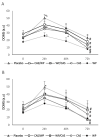Casein and Whey Protein in the Breast Milk Ratio: Could It Promote Protein Metabolism Enhancement in Physically Active Adults?
- PMID: 34201617
- PMCID: PMC8308344
- DOI: 10.3390/nu13072153
Casein and Whey Protein in the Breast Milk Ratio: Could It Promote Protein Metabolism Enhancement in Physically Active Adults?
Abstract
Due to the utilization of milk proteins such as whey protein (WP) and casein as sports nutrition ergogenic aids, the present study investigated the effects of the association of WP and casein in a ratio of 80:20, a similar ratio of human breast milk, on blood branched-chain amino acid (BCAA) profiles, markers of protein metabolism and delayed onset muscle soreness (DOMS), after a single bout of resistance exercise. A double-blind, crossover and acute study was carried out with ten men (age 29 ± 8 years; BMI: 25.4 ± 2.9 kg/m2; 77 ± 12 kg; 1.74 ± 0.09 m); each one consumed the following supplements randomly, one per session: WP, CAS (casein), WP/CAS (80% WP/20% CAS), CAS/WP (80% CAS/20% WP) and PLA (placebo). They were also subjected to the following evaluations: the one repetition maximum (1RM) test; resistance training session; blood extraction during each session to determine the BCAA profile; two food records; 3-day evaluation of DOMS (24 h, 48 h and 72 h) and nitrogen balance in each treatment. The intervention resulted in similar nitrogen urinary, creatinine and urea plasma levels and showed a positive nitrogen balance in all the trials. Regarding the BCAAs, the peak occurred at 60 min post-ingestion and remained higher until 120 min for WP, WP/CAS and CAS/WP. The DOMS was significantly lower for WP, WP/CAS and CAS/WP compared to the CAS and PLA treatments. There were no advantages in the association of WP and CAS in the BCAAs profile when compared to WP itself, but it induced a lower DOMS compared to CAS and PLA (Clinical Trial registration number: clinicaltrials.gov, NCT04648384).
Keywords: DOMS; amino acids profile; nitrogen balance; resistance exercise.
Conflict of interest statement
The authors B.S.M.G., F.G.D.C., S.C.S.C., C.F.C.B., G.A., S.I.M.T., M.S.S.M., S.S., G.U.O., J.S.M., J.C.A., and E.C.d.F. declare that they have no conflict of interest.
Figures


References
-
- Morton R.W., Murphy K.T., McKellar S.R., Schoenfeld B.J., Henselmans M., Helms E., Aragon A.A., Devries M.C., Banfield L., Krieger J.W., et al. A systematic review, meta-analysis and meta-regression of the effect of protein supplementation on resistance training-induced gains in muscle mass and strength in healthy adults. Br. J. Sports Med. 2018;52:376–384. doi: 10.1136/bjsports-2017-097608. - DOI - PMC - PubMed

